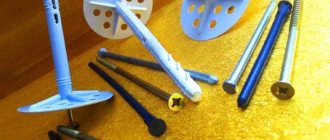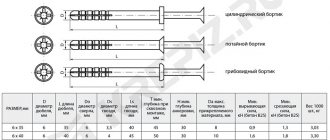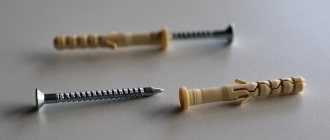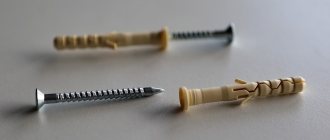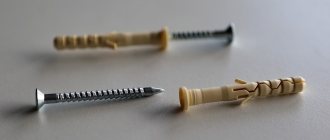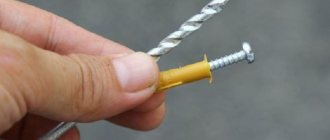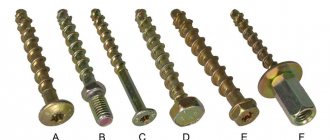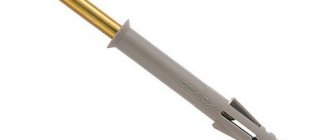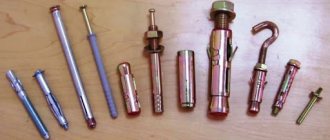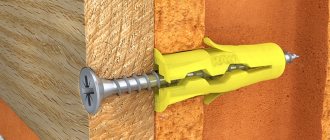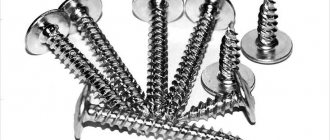A dowel-nail is a composite structure consisting of two elements - a dowel designed to be installed directly into a drilled hole, and a nail inserted into the dowel onto which fasteners are made.
Type: countersunk, cylindrical, mushroom-shaped Dowel material: HDPE (low-density polyethylene), polypropylene, nylon Nail material: carbon steel Coating: galvanized, yellow-passed Purpose: for fastening various materials to concrete, lightweight concrete and hollow and solid bricks.
Design features of nylon dowel-nail
A dowel-nail is a fastener designed to secure any objects in solid materials, for example, brick or concrete walls. A nail is a metal pin that is a hybrid of a nail and a screw. The dowel-nail has a smooth base, a sharp end and a thread in the middle.
The design of the dowels is simple, but at the same time very effective. Reliability of fastening is achieved solely due to friction. Because when installing a nail or screw into a plastic dowel, it increases significantly in width, thereby wedging itself inside the drilled hole. Installation of dowels is completely safe, does not reduce the strength of the walls and cannot cause cracks.
Summarize:
- Assembly with nails is faster and more convenient.
- The nail is more flexible, so if there is an excessive load on the cut, it bends, but “holds.”
- A nail is much less likely to cause cracks in the material.
- The nail is less susceptible to rusting and destruction due to corrosion.
- Nails are cheaper than high-quality self-tapping screws.
- Self-tapping screws are more resistant to pull-out loads.
- The screws can be unscrewed.
- In most cases, self-tapping screws require drilling.
- Working with a screwdriver is easier, but a nailer requires more skill.
When choosing between these two groups of fasteners, the most important factor is the type of load to which the connection is subjected.
When the force is applied to the fastener along its axis - to pull out - a self-tapping screw is the best choice, but in situations where the force is applied across the axis (to shear), a nail is the best choice.
Features of installing nylon dowel nails
Installation of dowel nails can be carried out either manually or using a special semi-automatic device - a construction and installation gun. Before installing the dowel, you must drill a hole. This is done using a conventional drill. It is important that the diameter of the hole and the dowel are almost the same, otherwise the connection will not be reliable.
The most commonly used sizes are: dowel-nail 6x40 and dowel-nail 6x60. The price for these sizes depends on the volume of purchase.
The modern market provides various types of dowel nails. They are a modification of a conventional dowel, the difference being the possibility of quick installation by hammering it into the wall. Such fasteners are widely used when performing repair work: they make it possible to securely and quickly fasten any material to the ceiling, wall or floor covering.
Dowel for mounting gun
In general, calling such a fastener a dowel is only a stretch. And then, only due to the similarity of the task solved with its help - mounting the object to the installation base. The design of this fastening element includes:
- a rod with a pointed end. There may be notches on the surface of this leg. The second design option is that there is no corrugation on the rod, and its surface is smooth;
- puck. It is installed on the rod by tension;
- a hat with a small protrusion that absorbs the impacts produced by the mounting gun during installation.
The operating principle of this type of dowel is simple. The centering washer, under the influence of a pistol shot while pressing the element being installed, moves from the pointed end to the head. In this case, it deforms and the dowel heats up. Installation is quicker because there is no need to drill a hole.
Carbon steel is used as a raw material for the production of this type of fastener. And to prevent the negative impact of the corrosion process, the surface of the product is covered with a protective zinc layer.
What is a dowel nail
It is a fastening element , hardware, consisting of two parts. The body is predominantly made of plastic, mounted either on a driven nail without a thread or with a thread.
The plastic side, at the moment when a nail is immersed in it, expands to the sides, with the help of which the body of the fastening component is fixed in the wall or some other surface.
The nail is made of high-strength steel and coated with a special anti-corrosion compound. As for the body, it is made of polypropylene or metal, but less commonly.
Dowel classification
The classification of dowels is divided into 3 aspects. What type of installation? What is the material of manufacture? Where will it be used? Let us present the basic facts about the classification of each aspect.
- Type of installation. The installation principle of the dowel is very simple. We are not talking about deepening the screw into the surface, but installing the sleeve itself. There are 2 types of installation work. Preliminary - the fastening is fixed into the base, and the material is adjacent to it. Through - the passage of fasteners through a layer of any material or between a void.
- Material. The bushing can be made of either plastic or metal. Plastic products are several times cheaper, but they also serve for a long time and do not lose their properties. Metal dowels are coated with an anti-corrosion coating. They are reliable, but their prices are much higher.
- Application area. Of course, it is worth taking into account the surface material, but also not forgetting about the features of the fasteners and their performance characteristics. There are general purpose dowels that fit everywhere. And special - limited scope.
Advantages of the fastener
This hardware has the following positive aspects:
- the ability to fasten various objects in all kinds of building materials;
- relatively simple installation. A hole is drilled in the wall corresponding to the diameter of the housing, a plastic housing is placed inside the resulting recess, and a rod is driven or screwed into it, depending on the type of nail;
- strong fastening is guaranteed due to the increasing antennae;
- quite low price in stores.
Surface material for work
For brick and concrete, a nylon dowel is often used. This fastening element can cope with enormous loads, supporting up to 450 kg. To place it in aerated concrete, a special nail with spiral ribs is used, which unstick and get stuck in the material at the moment of driving.
If the surface is solid or hollow, then a frame dowel or nail is used. If it is necessary to fasten the sheathing, then spacer hardware is used. Due to its design, small unevenness in the walls can be successfully leveled out.
Existing types of hardware
As part of this article, we offer you several types of this hardware:
Universal. Combines perfectly with all kinds of building materials. Multifunctionality comes down to the fact that this product can be used in hollow, sheet, solid and other surfaces. Reliability of fastening is guaranteed by toothed locking elements . The presence of such construction auxiliary items prevents the nail from twisting in the material. Its scope of application is very wide: from fastening household items to collecting construction and installation elements.
Spacer. The dowel is characterized by a four-sided expansion. Due to this, a uniform load on the material is maintained. Effective when fastening in hollow and solid surfaces. When installing a spacer dowel, damage to the surface of wood, tiles, plaster, etc. is avoided. This is achieved due to the special structure of the dowel neck. Accordingly, it is effective when fastening ceramic sanitary equipment.
For aerated concrete GB Core specialization is aerated concrete. It is especially effective for installation and repair work: fastening roof structures, suspended ceilings and much more. The main feature is that they are used for both internal and external fastening. A secure fit in the soft material is guaranteed thanks to the external ribs, which feature a spiral shape.
Turbo Dowel FTP D and FTP. Used for fastening various elements in aerated concrete. Has a nylon dowel. Can be used in combination with wood screws and metric threads. Has a self-tapping thread. There is a modification of this metal hardware. Used for work on aerated concrete and metric blocks.
Mounting gun
This equipment deserves a separate discussion. The division into types of mounting gun is carried out according to several criteria. The main one is the source of energy.
Gas
A nailer (this is the name of a nail gun in builders' slang) of this type is characterized by great power. It is charged with a special one-time cylinder, the cost of which is quite high. Used for work on large objects. It is not advisable to purchase it to solve everyday problems: it will pay for itself within at least several years. The operating principle is similar to an internal combustion engine.
- Gas from the cylinder is supplied to the combustion chamber.
- Its ignition occurs after pressing the trigger of the pistol, which looks like a button.
- The increased pressure activates a piston mechanism that pushes the fastener out.
This type of mounting gun has one significant drawback. The seal may leak gas, so a charged cylinder must be used until it becomes empty during work.
Pneumatic
The most budget option for a nailer. However, to work with it, additional equipment is required in the form of a compressor equipped with a receiver.
The pneumatic mounting gun is characterized by medium-level power. Meanwhile, he is able to solve a wide range of tasks, with the exception of working with installation bases made of thick metal, natural stone, and reinforced concrete.
The operating principle is as follows:
- air is supplied from the compressor through the hose into the gun itself;
- the trigger button is pressed;
- the pressure sharply pushes the piston out and the fastener shoots out.
The advantages of this device are fairly quiet operation and no recoil. Of the minuses, it is worth noting the cost of electricity consumed by the compressor. In addition, the hose interferes with the work.
Porokhovaya
The most powerful nailer. Stitches the installation base of any degree of hardness. But both the tool itself and the consumables required for its use are quite expensive. It works on a principle similar to a firearm.
- The fastener is inserted into the nose/barrel of the gun, and the blank cartridge is inserted into a special place located at the rear of the device.
- The gases from the gunpowder burned after the shot expand, causing the piston to move and thus act on the dowel.
On sale you can find different versions of the powder nailer - single- and multi-shot. In some designs they are combined. For example, a pistol is designed to use fasteners in a belt, but after each shot fired it must be loaded with a new blank cartridge.
Electric
Cordless and corded mounting guns are available on the market. The price of such a tool is quite high; not every home craftsman will be able to purchase it. It only makes sense to buy an electric mounting gun if you are going to use it every day. Suitable for working with various installation bases, including brick and wood. The advantage of a cordless gun is its independence from the need to connect to an electrical outlet.
Areas of application
The mounting gun is used to solve, as a rule, the following tasks:
v fastening of soft roofing material. Although such work is not among the most difficult, its implementation is associated with a large investment of time. It is also worth remembering the human factor. It causes not the most even fixation of the installed fastening elements:
v installation of façade siding on the wall. When it comes to decorative siding trim, a professional understands the difficulty of attaching specialty components. Manual work requires considerable time and physical effort of the performer. Especially when the wall was built from monolithic concrete. In this case, the use of a mounting gun will help out: the time for the monotonous work of installing dowels and labor costs will be significantly reduced;
v laying of engineering and technical communications. It is necessary to understand that the result of installation work depends on a number of factors, including the speed at which fasteners are driven in. For example, when they are installed slowly, the element to be fixed may change its location in space, in other words, become skewed. This phenomenon can cause deterioration in the operation of the electrical and telecommunications network. Quick fixation with punctual installation technology will prevent such unpleasant consequences. To ensure the best result, accurate calculations and creation of appropriate markings will be required.
Plastic and metal types
Let's compare the features of metal and plastic dowels.
Plastic variety
It has a hollow cylindrical rod. As the base is hammered in, the plastic part gradually expands. Its upper side is often equipped with a cuff, due to which the fasteners do not fall into the drilled hole.
The cuff has a cylindrical or hidden shape. To create additional fixation, some varieties are additionally equipped with “antennae”. Nails are sometimes threaded, sometimes without; there may be a slot on the head.
Metal variety
This type of metal dowel is equipped with a rod with a smooth surface. The mount is entirely made of metal. In a hole in the wall, the steel casing begins to expand as the nail or metal rod is screwed in. The installation process itself is simple, but dismantling it will require effort. But this provides very reliable fastening of various workpieces.
The client’s choice will not be hampered by the lack of suitable hardware for fastening: a wide variety of dowel nails are freely available in stores. Just before choosing a dowel, it is recommended to take into account the structure of the surface and the weight of the object being fastened.
Because You are not logged in. To come in.
Because The topic is archived.
In what cases is a dowel-nail used, and in what cases is a dowel with a self-tapping screw used? For example, now I want to hang curtains (cornices) under the curtains at home. What to mount on - is there a difference?
Professionals, be lenient with dummies! :)))) ¶
FAQ:
— What is better to use when building a frame house – nails or self-tapping screws?
The main fastener in frame house construction is a nail (smooth, screw, rough), since a self-tapping screw does not have sufficient structural strength. You can also use special structural self-tapping screws, which are highly resistant to destruction, but they cost 5-10 times more than nails, so their use is not economically viable.
Smooth, rough, screw
Regular yellow screws can be used when assembling the frame, but only with perforated fasteners. The corner joint will hold shear loads just as well as nails. But again, this is an expensive method - each rack will require four corners: two at the bottom and two at the top. And this is already additional expenses.
A rough nail with a conical head is excellent for attaching perforated joist supports and beam supports. It has a high holding capacity and can withstand large shear loads, and its conical head wedges into the perforated holes of the supports, so that such fasteners are not in danger of breaking.
— What is the best way to fasten a wooden roof sheathing?
To fasten the roof sheathing and counter-lattice, you can use both screws and nails, recessing them by 2 mm. Both must be galvanized. But it should be remembered that if the rafter system is insufficiently rigid or if insufficiently dried lumber is used, a smooth nail can come out over time and, coming into contact with the roofing, damage it. The best option is galvanized rough nails, which are highly resistant to tearing out.
— Fasteners for OSB: nail or screw?
OSB board is a universal material that can be attached to a wooden frame with both self-tapping screws and nails. When choosing between them, you need to take into account the installation location and the load on the slab. For example, if this is the future foundation for a soft roof, then high-quality fastening of OSB to the rafters can be achieved using ring or spiral nails, or yellow structural screws.
When cladding a frame house with OSB sheets, you should use nails, not self-tapping screws. This is due precisely to the fact that nails are more resistant to the “walking” of OSB panels. The length of the fastener is selected based on the thickness of the slab plus 5 cm for installation in a wooden frame.
“Is it possible to attach OSB to black self-tapping screws?” — It is possible if the slab is used to create internal partitions or decorative decoration of premises. But we are only talking about high-quality black wood/plasterboard screws. Experienced craftsmen distinguish them visually by a reinforced base under the head, a sharper tip, and a clear and fairly deep slot. The use of low-quality, low-strength analogues can lead to the head being torn off.
Sheathing with OSB board and black screws
Announcements on NN.RU – Construction
Discount on replacing the third radiator in an apartment - 50% (the discount only applies to the work itself) Summer radiator cleaning. Price: 1,200 rub.
Technical supervision services in Nizhny Novgorod and the region. Technical supervision of the construction of public, industrial, residential buildings. Price: 3,000 rub.
Quickly and inexpensively installing an electric meter, dismantling and installing chandeliers and lamps, repairing electrical wiring in the house Price: 800 rub.
White silicate brick, hollow. High quality facing brick. On pallet: 336 pcs. Delivery throughout the region. Call. Price: 8 rub.
